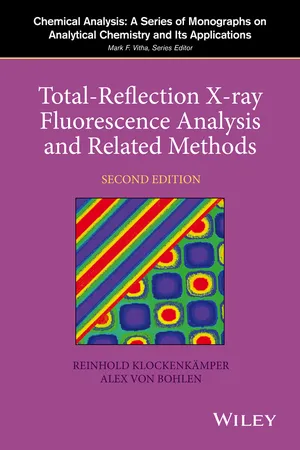
eBook - ePub
Total-Reflection X-Ray Fluorescence Analysis and Related Methods
This is a test
- English
- ePUB (mobile friendly)
- Available on iOS & Android
eBook - ePub
Total-Reflection X-Ray Fluorescence Analysis and Related Methods
Book details
Book preview
Table of contents
Citations
About This Book
Explores the uses of TXRF in micro- and trace analysis, and in surface- and near-surface-layer analysis
•Pinpoints new applications of TRXF in different fields of biology, biomonitoring, material and life sciences, medicine, toxicology, forensics, art history, and archaeometry
•Updated and detailed sections on sample preparation taking into account nano- and picoliter techniques
•Offers helpful tips on performing analyses, including sample preparations, and spectra recording and interpretation
•Includes some 700 references for further study
Frequently asked questions
At the moment all of our mobile-responsive ePub books are available to download via the app. Most of our PDFs are also available to download and we're working on making the final remaining ones downloadable now. Learn more here.
Both plans give you full access to the library and all of Perlego’s features. The only differences are the price and subscription period: With the annual plan you’ll save around 30% compared to 12 months on the monthly plan.
We are an online textbook subscription service, where you can get access to an entire online library for less than the price of a single book per month. With over 1 million books across 1000+ topics, we’ve got you covered! Learn more here.
Look out for the read-aloud symbol on your next book to see if you can listen to it. The read-aloud tool reads text aloud for you, highlighting the text as it is being read. You can pause it, speed it up and slow it down. Learn more here.
Yes, you can access Total-Reflection X-Ray Fluorescence Analysis and Related Methods by Reinhold Klockenkämper, Alex von Bohlen in PDF and/or ePUB format, as well as other popular books in Physical Sciences & Analytic Chemistry. We have over one million books available in our catalogue for you to explore.
Information
Chapter 1
Fundamentals of X-Ray Fluorescence
- 1.1 A Short History of XRF
- 1.2 The New Variant TXRF
- 1.2.1 Retrospect on its Development
- 1.2.2 Relationship of XRF and TXRF
- 1.3 Nature and Production of X-Rays
- 1.3.1 The Nature of X-Rays
- 1.3.2 X-Ray Tubes as X-Ray Sources
- 1.3.3 Polarization of X-Rays
- 1.3.4 Synchrotron Radiation as X-Ray Source
- 1.4 Attenuation of X-Rays
- 1.4.1 Photoelectric Absorption
- 1.4.2 X-Ray Scatter
- 1.4.3 Total Attenuation
- 1.5 Deflection of X-Rays
- 1.5.1 Reflection and Refraction
- 1.5.2 Diffraction and Bragg's Law
- 1.5.3 Total External Reflection
- 1.5.4 Refraction and Dispersion
X-ray fluorescence (XRF) is based on the irradiation of a sample by a primary X-ray beam. The individual atoms hereby excited emit secondary X-rays that can be detected and recorded in a spectrum. The spectral lines or peaks of such a spectrum are similar to a bar-code and are characteristic of the individual atoms, that is, of the respective elements in the sample. By reading a spectrum, the elemental composition of the sample becomes obvious.
Such an XRF analysis reaches near-surface layers of only about 100 μm thickness but generally is performed without any consumption of the sample. The method is fast and can be applied universally to a great variety of samples. Solids can be analyzed directly with no or only little sample preparation. Apart from the light elements, all elements with atomic numbers greater than 11 (possibly greater than 5) can be detected. The method is sensitive down to the microgram-per-gram level, and the results are precise and also accurate if matrix-effects can be corrected.
For these merits, XRF has become a well-known method of spectrochemical analysis. It plays an important role in the industrial production of materials, in prospecting mineral resources, and also in environmental monitoring. The number of spectrometers in use is estimated to be about 15 000 worldwide. Of these, 80% are working in the wavelength-dispersive mode with analyzing crystals; only 20% operate in the energy-dispersive mode, mainly with Si(Li) detectors, and recently with Si-drift detectors. At present, however, energy-dispersive spectrometers are four times more frequently built than wavelength-dispersive instruments due to the advantage the former provides in fast registration of the total spectrum.
A spectrum originally means a band of colors formed by a beam of light as seen in a rainbow. The Latin word “spectrum” means “image” or “app...
Table of contents
- Cover
- Series Page
- Title Page
- Copyright
- Foreword
- Acknowledgments
- List of Acronyms
- List of Physical Units and Subunits
- List of Symbols
- Chapter 1: Fundamentals of X-Ray Fluorescence
- Chapter 2: Principles of Total Reflection XRF
- Chapter 3: Instrumentation for TXRF and GI-XRF
- Chapter 4: Performance of TXRF and GI-XRF Analyses
- Chapter 5: Different Fields of Applications
- Chapter 6: Efficiency and Evaluation
- Chapter 7: Trends and Future Prospects
- Index
- End User License Agreement